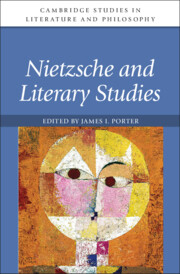Book contents
- Nietzsche and Literary Studies
- Cambridge Studies in Literature and Philosophy
- Nietzsche and Literary Studies
- Copyright page
- Contents
- Contributors
- Abbreviations
- Introduction
- 1 Heraclitus’ Clarity
- 2 Ariadne, or the Mediation of the Image
- 3 Nietzsche’s Centaurs
- 4 Nietzsche on the Task of the Poets in His Middle Writings
- 5 Some Images in Nietzsche’s Zarathustra
- 6 Nietzsche Ludens
- 7 Nietzsche and French Literature from the End of the Nineteenth Century to 1914
- 8 Ecce Mann
- 9 Plant Imaginaries and Human Existence in Nietzsche and Sartre
- 10 The Resources of the Figure
- 11 Nietzsche and Jewish Survival between Sarah Kofman and Jacques Derrida
- Editions and Translations of Nietzsche’s Works
- References
- Index
9 - Plant Imaginaries and Human Existence in Nietzsche and Sartre
Published online by Cambridge University Press: 03 May 2024
- Nietzsche and Literary Studies
- Cambridge Studies in Literature and Philosophy
- Nietzsche and Literary Studies
- Copyright page
- Contents
- Contributors
- Abbreviations
- Introduction
- 1 Heraclitus’ Clarity
- 2 Ariadne, or the Mediation of the Image
- 3 Nietzsche’s Centaurs
- 4 Nietzsche on the Task of the Poets in His Middle Writings
- 5 Some Images in Nietzsche’s Zarathustra
- 6 Nietzsche Ludens
- 7 Nietzsche and French Literature from the End of the Nineteenth Century to 1914
- 8 Ecce Mann
- 9 Plant Imaginaries and Human Existence in Nietzsche and Sartre
- 10 The Resources of the Figure
- 11 Nietzsche and Jewish Survival between Sarah Kofman and Jacques Derrida
- Editions and Translations of Nietzsche’s Works
- References
- Index
Summary
This chapter explores images of plant life in philosophy and literature with particular focus on the works of Friedrich Nietzsche and Jean-Paul Sartre. It pursues the question of what we can learn about the nature of the human being and its place in the world from plants and the way they are rooted in earth. Over the past half-century, many voices identify our disconnection from the earth with the centrality of technological progress, capitalist production, industrialization, and globalization that are essential to our modern self-understanding and way of life. What was supposed to be the root of human distinction has ended up uprooting us. Is this because we have a distorted view of what it means to be rooted in the first place, and our dependency on the rootedness of plant life? This chapter interrogates the metaphor of the root in Jean-Paul Sartre’s famous novel Nausea. Whereas Sartre considers the earth as an inert background in relation to human purposes: always there, meaningless, the earth is the static backdrop of our human drama, Nietzsche’s vegetal imaginary puts forward an idea of human life as deeply embedded in both earthly and planetary life.
Keywords
- Type
- Chapter
- Information
- Nietzsche and Literary Studies , pp. 210 - 229Publisher: Cambridge University PressPrint publication year: 2024



